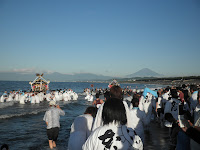


Summer reminds Japanese of importance of sea
The Nishihama beach of Chigasaki, Kanagawa Prefecture, was filled with more than 40 “mikoshi” portable shrines brought together from across the Pacific coast city and the neighboring town of Samukawa early Monday. The occasion was the Hamaori festival, which annually takes place on the Day of the Sea, a national holiday. Established in 1996, the day is one of the youngest national holidays in Japan. The Day of the Sea is designed to appreciate the blessings of the sea and pray for the prosperity of Japan as a sea-surrounded nation. The national holiday coincides with the full start of summer after the end of the”tsuyu” rainy season across Japan.
The Hamaori festival is one of a variety of events held on the national holiday throughout the country. Hamaori literally means descending on to the shore. The mikoshi shrines belong to shrines set up for each of the communities in the Chigasaki-Samukawa region. Mikoshi bearers bring the decorated structures into the sea so that the mikoshi may be purified and regenerated with the power of the sea water.
The Day of the Sea is currently observed on the third Monday of July, but it was originally set for July 20, the day when Emperor Meiji returned to Yokohama Port from an extended cruise to take a firsthand look at lighthouses in northeastern Japan in 1876. This was 16 years after about 170 Japanese, samurai warriors and their servants and sailors, risked their lives to travel across the Pacific aboard two ships in 1860. They reached San Francisco after months of hard voyage, and among them, members of a mission sent by the Tokugawa shogun for the ratification of the Japan-U.S. treaty of amity and commerce went on to Washington. They also visited New York and other places and received warm receptions from American people. They came to realize that the sea links countries to each other rather than separating countries. The mission was the first of a series of emissaries dispatched to foreign countries to negotiate or renegotiate treaties and agreements toward the end of the Tokugawa era in 1868.
The occasions enabled them to have a picture, if not sufficient, of the international situation and moves by Western countries toward Asia. Upon returning to Japan back across the Pacific, mission members wasted no time to report that Britain and the United States have strong interest in a group of largely inhabited islands in the western Pacific. The Tokugawa shogunate government quickly decided to develop the islands as a territory of Japan. This later paved the way for Japan to obtain ownership over the Ogasawara Islands, also known as the Bonin Islands.
The occasions enabled them to have a picture, if not sufficient, of the international situation and moves by Western countries toward Asia. Upon returning to Japan back across the Pacific, mission members wasted no time to report that Britain and the United States have strong interest in a group of largely inhabited islands in the western Pacific. The Tokugawa shogunate government quickly decided to develop the islands as a territory of Japan. This later paved the way for Japan to obtain ownership over the Ogasawara Islands, also known as the Bonin Islands.
The oceans now have become theaters for countries to vie with each other for natural and maritime resources. Japan has not only the Pacific to the east but also a vast sea lying to the west, the East China Sea, which has a resources-rich continental shelf. How to use natural resources in the area between Japan and China is expected to be one of the toughest jobs to be negotiated by the two countries. But the oceans should continue to link Japan to other countries and sometimes, serve as a buffer to avoid conflicts with neighboring countries.

No comments:
Post a Comment